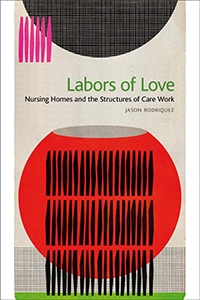There are more than 39.6 million people 65 years or older living in the United States. By 2030, that number will be 72.1 million, according to the Administration on Aging.
Jason Rodriquez wanted to know more about the health care workers in the nursing homes that provide care to the ever-growing aging population. The assistant professor of sociology spent 18 months doing extensive fieldwork and interviewing 65 staff members at two nursing home facilities — one for-profit and one nonprofit. The result is his first book, Labors of Love: Nursing Homes and the Structures of Care Work (New York University Press, 2014), published in October.
When Rodriquez began his investigation in 2007, he intended to focus on the emotions of the health care workers and their attachments to their patients. But in every interview, he found it difficult to avoid the financial side of the nursing home industry.
“I talk about the logic of care and the logic of cost and how those two are often in tension,” Rodriquez said. “A lot of the book is looking at how staff in nursing homes manage that tension and how that ends up influencing their work and how they experience their jobs.”
Most surprising to Rodriquez was that, although the nonprofit had more altruistic intentions than the for-profit, ultimately the nonprofit had to run its operation like the for-profit because both nursing homes relied on the fee-for-service reimbursement system. For example, if a nurse helps feed a resident, the nursing home can submit a bill to Medicaid for reimbursement. Rodriquez argues that this system negatively influences the way nursing home staff approach their job and incentivizes patient dependency.
He recounted an interview he conducted with a for-profit nursing home manager who processed Medicaid reimbursements. “ ‘I always say their loss is our gain,’ she said to me, meaning residents’ physical losses are the financial gain to the facility.” Rodriquez said a manager at the nonprofit chided a speech therapist who restored a person’s ability to eat. She said to Rodriquez, “Great, so we’ve done such a good job we get paid less.”

“The fee-for-service system incentivizes dependence and incapacity rather than independent living and restoring the ability of someone who has a stroke to eat or walk independently because if the nursing home does do that, they get paid less,” Rodriquez said.
Although there is a movement to make cultural changes in nursing homes, such as allowing pets and letting nursing home residents eat and do activities at their own pace, Rodriquez said those changes won’t be that effective unless there is a structural change in how nursing homes are paid.
“What if the payment systems reimbursed nursing homes for cultivating large volunteer networks or for improving the quality of the food? What if nursing homes were paid to make residents more independent, to restore lost abilities?
“There is going to be no substantial cultural change until there is major structural change,” Rodriquez said.
Part of those structural changes involves making working conditions better for the nursing home staff. In nearly every interview Rodriquez conducted, from floor staff to upper-level management, employees said the pay and benefits weren’t great and their jobs weren’t respected or prestigious.
“But they love their residents. That’s what makes the work valuable,” Rodriquez said. “There is going to be a huge growth in nursing home population over the next 20 to 30 years, and we’re not really prepared for that. We have to make the job more attractive to people who are interested in doing it but don’t want to get paid $10 an hour and endure tough working conditions.”
Rodriquez, who considers himself a medical sociologist, is already 18 months into his next project: researching medical teamwork in an intensive care unit. “My approach is to think about health services organizations as workplaces,” he said. “I’m interested in the people who work there and what it’s like to work there.”
Labors of Love is available for purchase on the NYU Press website.
— Kelsey Allen
